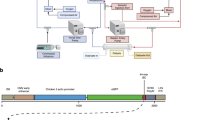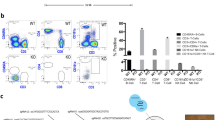Abstract
Delivering retroviruses targeted to hepatocytes in vivo involves the injection of retroviruses directly into the portal vein. The aim of this work was to establish a clinically relevant system for retrovirus-mediated gene transfer in a new model of in vivo, in situ perfused rat liver and to study the transgene expression. At 24 h after partial hepatectomy, the liver was completely excluded from the splanchnic circulation using an extracorporeal shunt. Two independent normothermal, oxygenated perfusion systems were used. First, liver perfusion was carried out with a recirculating system (1 h). Culture supernatant containing retroviruses (1.5 × 108 ffu/ml, β-galactosidase gene) was used as perfusate. Then the liver perfusion was maintained for more 30 min in a single liver passage system using culture medium without retroviruses as perfusate. High hepatocyte transduction rates (up to 34.4%) were obtained. PCR analysis showed no provirus in extrahepatic organs. Viral titrations performed simultaneously (inflow and outflow liver lines) showed that after 1 h of perfusion (up to 30 successive liver passages) retroviruses were still detected in the liver outflow perfusate (up to 2.0 × 107 ffu/ml). Washing the liver for 30 min dramatically decreased the leakage of retroviruses in the outflow. In order to be of clinical use, the injection of retroviruses targeted to hepatocytes in vivo should be done while the liver is completely excluded from the splanchnic circulation to avoid any extrahepatic retrovirus diffusion.
This is a preview of subscription content, access via your institution
Access options
Subscribe to this journal
Receive 12 print issues and online access
$259.00 per year
only $21.58 per issue
Buy this article
- Purchase on Springer Link
- Instant access to full article PDF
Prices may be subject to local taxes which are calculated during checkout




Similar content being viewed by others
References
Anderson W . Human gene therapy Nature 1998 392: 25–30
Kay M, Woo S . Gene therapy for metabolic disorders Trends Genet 1994 10: 253–257
Ledley F . Clinical application of somatic gene therapy in inborn errors of metabolism J Inherit Metab Dis 1990 13: 597–616
Ledley F . Hepatic gene therapy: present and future Hepatology 1993 18: 1263–1273
Mulligan R . The basic science of gene therapy Science 1993 260: 926–932
Grossman M, Wilson J . Retroviruses: delivery vehicle to the liver Curr Opin Genet Dev 1993 3: 110–114
Miller A . Retroviral vectors Curr Top Microbiol Immunol 1992 158: 1–24
Salmons B et al. Construction of retroviral vectors for targeted delivery and expression of therapeutic genes Leukemia 1995 9: S53–S60
Vile R, Russell S . Retroviruses as vectors Br Med Bull 1995 51: 12–30
Boris-Lawrie K, Temin H . Recent advances in retrovirus vector technology Curr Opin Genet Dev 1993 3: 102–109
Varmus H . Retroviruses Science 1988 240: 1427–1435
MacDonald R . ‘Lifespan’ of liver cells Arch Intern Med 1961 107: 335–343
Chowdhury J et al. Long-term improvement of hypercholesterolemia after ex vivo therapy in LDLR-deficient rabbits Science 1991 254: 1802–1805
Kay M et al. Hepatic gene therapy: persistent expression of human α 1-antitrypsin in mice after direct gene delivery in vivo Hum Gene Ther 1992 3: 641–647
Kaleko M, Garcia J, Miller A . Persistent gene expression after retroviral gene transfer into liver cells in vivo Hum Gene Ther 1991 2: 27–32
Hatzoglou M et al. Hepatic gene transfer in animals using retroviruses containing the promoter from the gene for phosphoenolpyruvate carboxykinase J Biol Chem 1990 265: 17285–17293
Kay M et al. In vivo gene therapy by hemophilia B: sustained partial correction in factor IX-deficient dogs Science 1993 262: 117–119
Rettinger S et al. Liver-directed gene therapy: quantitative evaluation of promoter elements by using in vivo retroviral transduction Proc Natl Acad Sci USA 1994 91: 1460–1464
Steer C . Liver regeneration FASEB J 1995 9: 1396–1400
Miller D, Adam M, Miller A . Gene transfer by retrovirus vectors occurs only in cells that are actively replicating at the time of infection Mol Cell Biol 1990 10: 4239–4242
Higgins G, Anderson R . Experimental pathology of the liver I. Restoration of the liver of the white rat following partial surgical removal Arch Pathol 1931 12: 186–212
Roe T et al. Integration of murine leukemia virus DNA depends on mitosis EMBO J 1993 12: 2099–2018
De Godoy JL et al. Hepatic regeneration in the isolated perfused rat liver followed by liver transplantation Hepatology 1998 27: 697–702
Ferry N et al. Retroviral-mediated gene transfer into hepatocytes in vivo Proc Natl Acad Sci USA 1991 88: 8377–8381
Cardoso J et al. In situ retrovirus-mediated gene transfer into dog liver Hum Gene Ther 1993 4: 411–418
Lautt W . Mechanism and role of intrinsic regulation of hepatic arterial blood flow: hepatic arterial buffer response Am J Physiol 1985 249: G549–G556
Andersen K, Nexo B . Entry of murine retrovirus into mouse fibroblasts Virology 1983 125: 85–98
Bowles N et al. A simple and efficient method for the concentration and purification of recombinant retrovirus for increased hepatocyte transduction in vivo Hum Gene Ther 1996 7: 1735–1742.
Kotani H et al. Improved methods of retroviral vector transduction and production for gene therapy Hum Gene Ther 1994 5: 19–28
Paul R et al. Increased viral titer through concentration of viral harvests from retroviral packaging lines Hum Gene Ther 1993 4: 609–615
Kitten O, Cosset F, Ferry N . Highly efficient retrovirus-mediated gene transfer into rat hepatocytes in vivo Hum Gene Ther 1997 8: 1491–1494
De Godoy JL et al. In vivo hepatocyte retroviral-mediated gene transfer through the rat biliary tract Hum Gene Ther 1999 10: 249–257
Patijn G et al. High-efficiency retrovirus-mediated gene transfer into the livers of mice Hum Gene Ther 1998 9: 1449–1456
Grisham J . A morphologic study of deoxyribonucleic acid synthesis and cell proliferation in regenerating rat liver; autoradiography with thymidine-H3* Cancer Res 1962 22: 842–849
Rabes H et al. Analysis of cell cycle compartments of hepatocytes after partial hepatectomy Cell Tissue Kinet 1976 9: 517–532
Vara J et al. Cloning and expression of a puromycin N-acetyl transferase gene from Streptomyces alboniger in Streptomyces lividans and Escherichia coli Gene 1985 33: 197–206
Graham F et al. Characteristics of a human cell line transformed by DNA from human adenovirus type 5 J Gen Virol 1977 36: 59–72
Sitbon M et al. Hemolytic anemia and erythroleukemia, two distinct pathogenic effects of Friend MuLV: mapping of the effects to different regions of the viral genome Cell 1986 47: 851–859
Graham F, Van Der Eb A . A new technique for the assay of infectivity of human adenovirus 5 DNA Virology 1973 52: 456–467
Markowitz D, Goff S, Bank A . Construction and use of a safe and efficient amphotropic packaging cell line Virology 1988 167: 400–406
Kamada N, Calne R . Orthotopic liver transplantation in the rat – technique using cuff for portal vein anastomosis and biliary drainage Transplantation 1979 28: 47–50
Kamada N et al. Orthotopic rat liver transplantation after long-term preservation by continuous perfusion with fluorocarbon emulsion Transplantation 1980 30: 43–48
Hamilton R, Berry M, Williams M . A simple and inexpensive membrane ‘lung’ for small organ perfusion J Lipid Res 1974 15: 182–186
Nevasaari K . A simple membrane oxygenator for the isolated perfused rat liver perfusion Experientia 1976 32: 534–535
Gores G, Kost L, LaRusso N . The isolated perfused rat liver: conceptual and practical considerations Hepatology 1986 6: 511–517
Cardoso J et al. Augmentation of portal blood flow improves function of isolated perfused human cirrhotic livers Hepatology 1994 19: 375–380
Morgan J et al. Rapid quantitation of recombinant retroviruses Biotechnol Prog 1994 10: 441–446
Sambrook J, Fritsch E, Maniatis T . In vitro amplification of DNA by the polymerase chain reaction. In: Nolan C (ed) Molecular Cloning: A Laboratory Manual Cold Spring Harbor Laboratory Press: New York 1989 pp 14.1–14.35
Olthoff K et al. Adenovirus-mediated gene transfer into cold-preserved liver allografts: survival pattern and unresponsiveness following transduction with CTLA4Ig Nature Med 1998 4: 194–200
Acknowledgements
We are grateful to Dr Andrea Pavirani for kindly providing packaging cell line. We thank Dr Horst Homann, Nathalie Ba and Yves Poitevin for their expert technical assistance.
Author information
Authors and Affiliations
Rights and permissions
About this article
Cite this article
De Godoy, J., Malafosse, R., Fabre, M. et al. A preclinical model of hepatocyte gene transfer: the in vivo, in situ perfused rat liver. Gene Ther 7, 1816–1823 (2000). https://doi.org/10.1038/sj.gt.3301313
Received:
Accepted:
Published:
Issue Date:
DOI: https://doi.org/10.1038/sj.gt.3301313
Keywords
This article is cited by
-
Improved retroviral suicide gene transfer in colon cancer cell lines after cell synchronization with methotrexate
Journal of Experimental & Clinical Cancer Research (2011)



